
Worldcarblog.com
Mazda is leaving Russia
Asian media reports that Mazda will sell its stake in the Russian joint venture to local carmaker Sollers.
The Japanese automaker has been looking for ways to wind down its Russian operations since the invasion of Ukraine in February. In March, they confirmed that the export of parts to the Vladivostok factory would end and that production would cease when these stocks were used up. The factory produced around 29,000 vehicles in 2021, Nikkei Asia reminds.
According to media reports, Sollers is currently negotiating with Mazda to buy out its share in the joint venture.
"Sollers Auto has already developed a plan to restart the plant for the production of other car brands and negotiations on this matter are currently being concluded," Sollers confirmed in a statement.
Mazda's move to leave Russia comes shortly after Toyota confirmed it was also pulling out of its Russian operations. Toyota highlighted difficulties in obtaining parts and the need to compensate workers, stating that there is no prospect of resuming production in the near future due to the parts shortage.
Volvo XC40 review
The Volvo XC40 is a comfortable and stylish small SUV that has some pleasing practical touches and a lot of Swedish cool
Verdict
The Volvo XC40 is a strong contender in the market for small premium SUVs. It’s not a revelation on the road, but it strikes a decent blend of comfort and cruising refinement, and offers premium SUV appeal in a small-car package. This allows passengers to enjoy the funky, minimalist cabin and the capable infotainment system.
Factor in competitive pricing when compared to rivals, as well as Volvo's traditional focus on safety, and you’re left with one of the most appealing offerings on the market. That's why we made the XC40 our Small Premium SUV of the Year in our 2018 New Car Awards.
About the Volvo XC40
Introduced in 2017, the Volvo XC40 is a mid-sized premium SUV that majors on practicality and comfort while offering bold styling that helps set it apart from its more conservative rivals. Its great safety rating and suite of available active safety systems will appeal to customers, too.
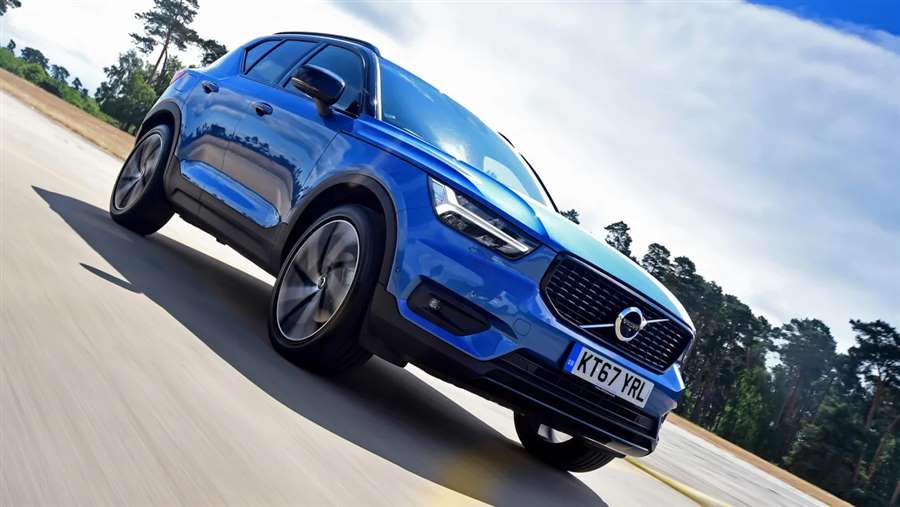
n terms of size and price, the XC40 slots into the Volvo SUV range below the XC60 and XC90, and is offered in Core, Plus and Ultimate trims.
There's a similar engine range too, and the XC40 receives the latest mild-hybrid ‘B’ engines from its bigger siblings. You can also buy plug-in hybrid and fully electric versions. Volvo aims to launch a fully electric car every year, as it seeks to make all-electric cars 50 per cent of global sales by 2025, with the rest hybrids. Recharge will be the overarching name for all chargeable Volvos with a fully electric and plug-in hybrid powertrain.
Rivals for the Volvo XC40 include the BMW X1 and X2 duo, the Jaguar E-Pace, Land Rover Discovery Sport, Range Rover Evoque, Audi Q2 and Q3 and Mini Countryman.
Where the XC40 stands out is with its fresh looks. The chunky lines define it as an SUV, yet its compact dimensions mean it's no more manageable than a compact hatchback.
Inside, the XC40 focuses on style, with a design-led interior that uses digital displays and quality materials to create an upmarket cabin which can be upgraded with a variety of individual options. Power comes from a range of three and four-cylinder petrol engines, along with B-badged mild-hybrid petrol versions.
The range kicks off with a B3-badged 161bhp petrol, then a 194bhp B4, while the 247bhp four-cylinder B5 is no longer available. The B3 is front-wheel drive and every version gets an eight-speed automatic as standard, while the B4 is offered with front- or all-wheel-drive.
The 208bhp Recharge T4 and the 258bhp Recharge T5 plug-in hybrids stick to front-wheel drive and an automatic gearbox, while Volvo has also introduced the XC40 P8 pure electric model with all-wheel-drive and 402bhp, along with a 228bhp all-electric Single Motor version.
Volvo previously matched a basic Start trim with the lower-powered 1.5-litre T2 petrol engine to create a single entry-level model, but this is no longer available. There are now three main trim levels – Core, Plus and Ultimate, which offer lots of kit as standard.
The Core model is well catered for, although there is a significant asking price of around £35,000. It comes with dual-zone climate control, 18-inch wheels, rear parking sensors, a powered boot, auto-folding door mirrors, cruise control and digital instruments all included. Also on board is Volvo’s excellent nine-inch portrait-layout infotainment system.
Plus adds extra kit such as a rear-view camera, keyless entry, a hands-free opening boot, heated front seats, a heated steering wheel and even a heated windscreen.
Ultimate is the plushest XC40, bringing a 12-speaker Harman Kardon stereo system, panoramic sunroof, adaptive Pixel LED headlights and a 360-degree camera view.
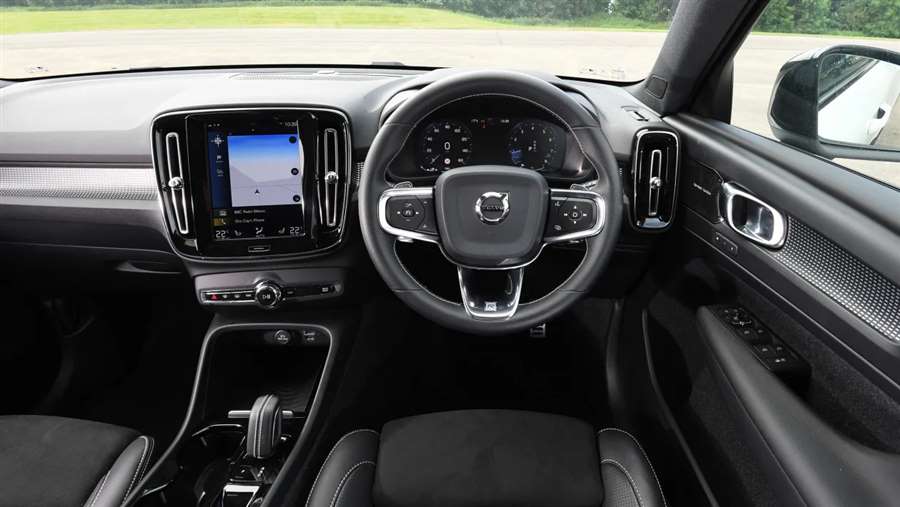
Volvo XC40 review - Engines, performance and drive
The XC40 majors on comfort and refinement instead of driving entertainment, and it does so rather well
The XC90 and XC60 are both based on Volvo’s Scalable Product Architecture (SPA) platform, but the XC40 is the first model from the Swedish brand to sit on the Compact Modular Architecture (CMA) underpinnings. This uses MacPherson strut suspension at the front and a multi-link rear axle, which means the new Volvo matches its German rivals for chassis technology under the skin. However, if you’re looking for dynamic sparkle and hot hatchback-rivalling agility down a country road, you’ll be better off elsewhere.
For everyone else, though, the XC40 strikes a nice balance between composure and comfort. It can get caught out on pockmarked city streets, particularly at low speeds and on the optional larger wheels - but provided you stick with the original items, you’re likely to find the baby Volvo a pretty relaxing place to spend time. This isn’t just down to ride quality, of course, because the engines do a good job of fading into the background too.
The engine does its best work between 1,500rpm and 3,000rpm, and the eight-speed auto is keen to shift up just before the higher of those figures. It’s nicely judged, really, because that’s also the point where the motor really identifies itself as a diesel, through a harsher note and increased volume.
It’s worth remembering, though, that should you want to get more involved in the gearshifting process, not every version is available with steering wheel-mounted shift paddles. And this restriction is compounded by the fact that the stubby gear selector between the front seats actually has a lateral shift pattern - pull it towards the driver to shift down, and push it towards the passenger to shift up. It’s a bizarre layout that will take even the most adaptable of drivers a long time to get used to.
Even on those optional wheels, at high speeds the XC40 does a good job of soaking up road imperfections. You’ll occasionally notice a slight floating effect, but it never strays to the point of making you seasick. Its trickiest moments come at low speeds around town, where you might find the car troubled by deep potholes. Then again, we’d expect a standard Momentum on 18-inch wheels to demonstrate a bit more compliance in this regard.
It wouldn’t be unreasonable to expect such a generally wafty small SUV to be boat-like in corners, but in fact, the XC40 stays composed, even when required to perform a sudden, rapid change of direction. The steering adds to the experience - not because it’s blessed with any great deal of feedback, but rather because it’s nicely weighted and pleasingly direct. Playing around with the car’s Drive Mode selector and switching it into Dynamic actually has a negative effect, in fact, because it adds heft to the steering instead of any discernible extra communication.
Ultimate models fitted with 19-inch alloy wheels feel firm on typically torn UK roads. The chassis deals with more flowing undulations well, but sharper bumps shock the chassis, whereas a BMW X1 smothers imperfections a little more adeptly.
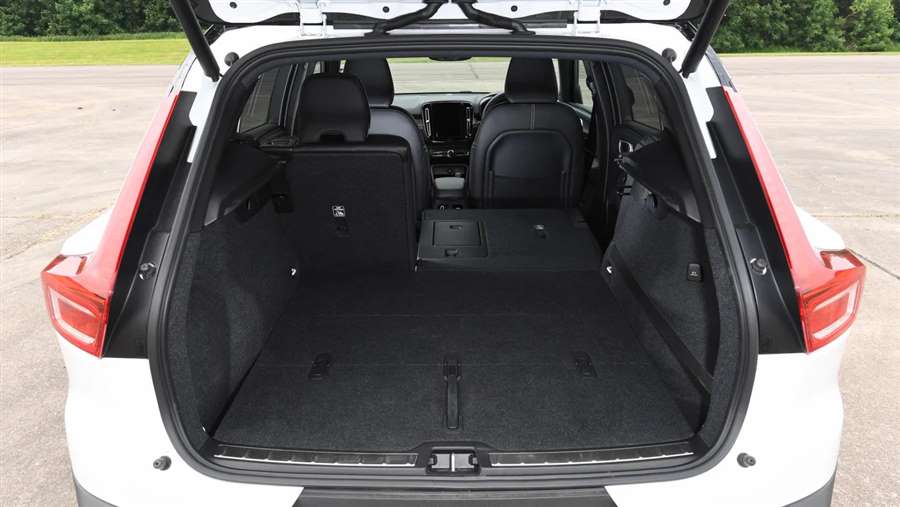
However, light steering and a well-judged chassis set-up means that the Volvo does at least respond well to inputs. It’s not as involving or as quick to change direction as the BMW, but for a tall SUV with a relatively short wheelbase, it offers a decent level of composure.
The XC40 has a mix of full electric, hybrid and turbocharged petrol engine options – with some petrol models having been refreshed in 2019 to offer more power and improved economy. The range starts with the mild-hybrid B3 four-cylinder petrol, producing 161bhp with a seven-speed automatic gearboxes. All B3 models are front-wheel drive.
Step up to the B4 with 194bhp and an automatic gearbox also comes as standard, but there's the choice of front- or four-wheel drive.
The 258bhp Recharge plug-in hybrid T5 model is powered by a 1.5-litre three-cylinder mated to an electric motor. It’s an impressive unit – with all that battery assistance, the three-cylinder motor feels like it lives a relatively unstrained life, but it’s capable of a proper turn of pace. Volvo’s claimed 7.3-second 0-62mph time points to solid performance, owing to the strong reserves of torque the XC40 Recharge can muster, and it does it with so much refinement too.
The cheaper Recharge T4 plug-in hybrid version produces 208bhp and gives away 1.2 seconds to its more powerful sibling in the sprint to 62mph.
Volvo has also added the 402bhp P8 pure electric Recharge model to the range. It makes use of two electric motors powered by a 78kWh battery and is capable of 0-62mph in a claimed 4.9 seconds. The 228bhp Single Motor version (with a 69kWh battery) needs a more leisurely 7.4 seconds to complete the benchmark sprint.
Volvo XC40 review - MPG, CO2 and running costs
Ballpark fuel efficiency, with respectable CO2, but the real gains come with the Recharge plug-in hybrid and pure-electric versions
The XC40’s engine line-up comprises state-of-the-art motors, with a wide range of electric, hybrid and petrol units. The efficiency figures on the XC40 are respectable for the class, but no better than that.
The cleanest XC40 models are the Recharge P8 pure electric and Single Motor which emit 0g/km. Next up are the Recharge T4 and T5 plug-in hybrid models which emit 47-49g/km, depending on chosen specification.
As you might expect, the standard petrol XC40 takes a hit on fuel efficiency and CO2 emissions; at 152g/km for the B3, it's probably a big enough tax hit for lots of company car choosers to overlook it. In reality, it’s a very thirsty unit, too - we struggled to get mid-thirties mpg out of the B3 in our time behind the wheel. The front-wheel drive B4 with mild-hybrid tech offers greater performance than the B3, and the same returns in real world economy.
Insurance groups
Insurance groups for the XC40 range from Group 18 to Group 32. On a like-for-like basis, the Volvo is ranked slightly lower than its German rivals - not least helped because of the Swedish brand’s reputation for passive and active safety systems.
Depreciation
Volvo is currently on the crest of wave in terms of customer demand, and when you also factor in the strong desirability within the premium SUV market, it's no surprise that the XC40 has strong residual values; 53 per cent for the all-electric models, and 57-62 per cent for mild-hybrid petrol and plug-in hybrid models.
Volvo XC40 review - Interior, design and technology
Bags of Swedish cool, with a clean, uncluttered design that still manages to incorporate some lovely practical touches
Volvo has deliberately moved the XC40 away from the more luxurious, grown-up presence offered by the larger XC60 and XC90 models – but that doesn’t mean there’s no scope for impressive design touches or the latest technology. Quite the opposite, in fact, because the baby Volvo brings something new to the premium small SUV market.
The car’s styling was inspired by small robots that the British designer, Ian Kettle, saw in science-fiction movies. The end result is lots of simple, clean, resolved lines - and a look that manages to look chunky and cute at the same time. It’s helped by a further evolution of Volvo’s ‘Thor’s Hammer’ headlight motif at the front end.
There’s more scope for personalisation than on the XC60 and XC90 too, thanks to contrast roof colours on some versions (black or white, depending on the trim level).
Inside, there’s not a great deal in the way of opulence - and yet the XC40 still manages to deliver a dose of Swedish cool, much in the same way as a well-resolved IKEA living room display. There’s remarkably little clutter and although the actual amount of space isn’t any greater than the class average, the Volvo’s plethora of neat practical touches makes the XC40 feel a lot more ‘real-world liveable’ than many of its rivals.
Technology helps with this too, of course. And in this respect, a slice of shameless carryover from the XC60 and XC90 works wonders – because the XC40 gets the same nine-inch portrait-layout infotainment display as its larger brothers, as well as a 12.3in digital instrument panel instead of conventional dials. These are standard across the range, too.
Sat-nav, stereo and infotainment
The XC40 uses a new Android-based operating system with built-in online Google services. It’s still displayed on a nine-inch portrait-oriented display, but the graphics are sharper and the shortcut keys bolder and less fiddly to use than previous Volvo set-ups – although they are still on the small side.
Loading times are good, however; the process from typing an address to the system loading the first navigation instruction took just 18 seconds, and Google’s live traffic info means the route and time to destination will be accurate, too.
There’s only one physical control; a single button below the screen takes you back to the home page, and the air-con settings are adjusted through the screen. For a first-time user, the set-up takes a little getting used to, but it’s hard to fault if you link it to a Google account.
Volvo XC40 review - Practicality, comfort and boot space
A well-judged amount of cabin space and some neat features to help maximise boot space make the XC40 more than practical enough
The XC40 enters a class where style and image have traditionally been more important than genuine space. But while the Volvo doesn’t deliver an aircraft hangar’s worth of room in the cabin, it manages to do enough to stand out from the crowd.
The XC40’s interior is neat, functional and, in its own way, very Swedish. If you’re absolutely set on having soft-touch fabrics and squishy plastic on the dashboard then you’ll probably judge it a disappointment, but the rest of us should find the interior a pretty special place to spend time.
The facia has relatively few switches, and a clean, uncluttered look. And depending on the trim you choose, and your bravery with the options list, there’ll be a vibrant flock lining in the enormous door bins to offer a dash of funky colour. The capacity of these door cubbies is huge, in fact - helped by Volvo’s decision to move the speakers out of their traditional area and arrange a sound system based around the top of the dashboard instead.
There are plenty of simple, clever touches, too. You’ll find a folding hook integrated into the glovebox that is designed to help you make it home without spilling a drop of your chicken chow mein. The rather flimsy-looking lidded compartment between the front seats turns out to be a removable, washable bin. And there’s also the option of a wireless phone charging pad and USB port at the base of the centre console.
A lengthy wheelbase helps with rear legroom - although the amount of headroom for back-seat passengers is equally impressive, even with the optional panoramic sunroof fitted. There’s plenty of room on board for four grown-ups, although a fifth adult may complain about the high transmission tunnel.
The boot isn’t the largest in the class, but the floor is commendably flat and there are some clever (optional) dividers that help to stop your shopping from rolling around when you’re on the move.
The Volvo XC40 is 4,425mm long, 1,863mm wide and 1,658mm tall. That makes it a little shorter than the BMW X1, but longer than an Audi Q3 - and it’s notably wider and taller than both of those rivals, too.
Leg room, head room & passenger space
Expect the XC40 to provide a cavernous cabin and you’ll be disappointed. But what the Volvo does do is maximise the potential of what space is on offer.
There’s plenty of space for two adults up front, and you’ll be able to fit a couple of grown-ups in the back seats easily too. The XC40 has a pretty long wheelbase, so they should be fine for legroom - and the amount of headroom for back-seat passengers is equally as impressive, even with the optional panoramic sunroof fitted.
Can you squeeze a third person into the rear seats? Yes, at a push. But there’s a transmission tunnel running down the middle of the floor, so they may complain about having to place their feet at either side of it.
Boot
The XC40 doesn’t boast the largest load bay in its class, but it’s easy to use what space is on offer there. That’s because the 452-litre boot has an impressively flat floor, with no lip at the front edge, so it’s easy to slide heavier items in there.
Spec the Convenience Pack and you’ll get a folding boot floor that can divide the space and stop your shopping from rolling around. The hinges even stand proud of the top edge of the resulting divider, giving you a few extra points from which to hang shopping bags.
Customers won't be short of room if they opt for one of the Recharge models, either. These cars include batteries that line the car’s spine, which crucially leaves the standard boot space unaffected. Due to the lack of an internal combustion engine, the Recharge P8 pure electric version also has an extra 30-litre storage bin under the bonnet.
Towing
The all-electric XC40 Recharge Single Motor is rated to tow up to 1,500kg, while the T4 and T5 plug-in hybrid models are both able to pull 1,800kg. The B3 petrol splits the difference with a 1,600kg maximum braked trailer weight, while buyers prioritising towing ability will be better served by the B4 version which has a 2,000kg limit in front-wheel-drive form and 2,100kg with an all-wheel-drive set-up.
Volvo XC40 review - Reliability and safety
A new platform, but some proven engines should help to keep the XC40 reliable. Bags of top-notch Volvo safety kit on board, too
The XC40 is built on Volvo’s latest CMA platform - and that means that its underpinnings are, in theory, relatively unproven. However, the Swedish firm has designed the chassis to accommodate its family of four-cylinder and three-cylinder petrol and diesel engines and hybrid motors and battery packs, many of which have seen use in other models before.
This, and the fact that the Volvo gets other components from larger stablemates (such as the infotainment system and some switches) should help it to achieve a pretty decent level of reliability.
Volvo finished ninth out of 29 manufacturers in our 2021 Driver Power customer satisfaction survey, with a one place jump to eighth overall in 2022. The XC40 achieved 23rd spot out of 75 cars in the best cars to own poll.
Safety continues to be a big priority for Volvo, and the XC40 doesn't disappoint. It scored five stars out of five in the Euro NCAP test, with an impressive 97 per cent for adult occupant protection and 87 per cent for child occupant protection. You get automatic emergency braking across the range – and it’s capable of spotting not only cars but also pedestrians and large animals. Plus every XC40 gets a lane departure system, which will intervene and pull the car back into lane if it senses you’re going to steer into the path of oncoming traffic.
Warranty
The XC40 comes with a three-year warranty, which is par for the course in the class, although the mileage limit for the cover is 60,000 miles instead of the industry-standard 36,000 miles.
Servicing
Volvo offers fixed-price service plans for its cars that can be paid for up front or on a monthly basis. These can last from two-five years and cover annual mileages up to 50,000 miles.
As a typical example, you can get three years of cover for around £1,000, although this can be added to any finance deal you may take out, which works out at around £30 extra a month on a three-year finance deal.
Source: autoexpres.co.uk
Retro is in fashion: Citroen presented a new logo PHOTO/VIDEO
The French manufacturer is just one of a number of automotive brands that marked the entry into the electric era by changing their visual identity.
Citroen has unveiled its new identity and logo, which is a reinterpretation of the original from 1919. The new logo will debut on the new concept before the end of September, before appearing on future production models starting in mid-2023.
This is the tenth revision of the logo in Citroen's 103-year history and the third in the last 13 years. Although the signature double "chevron" is retained, the oval exterior shape is a departure from previous interpretations and a return to the original.
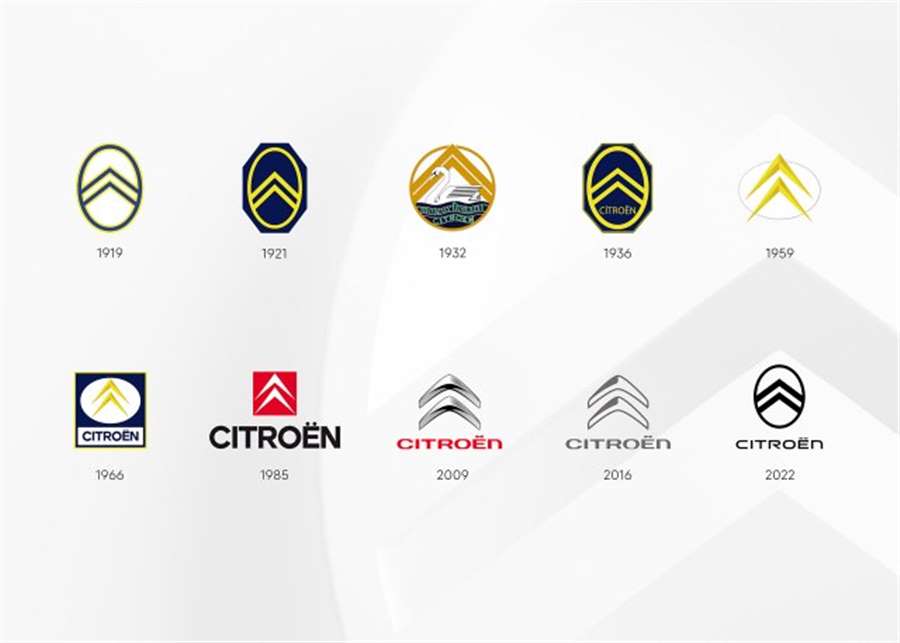
Namely, this design was chosen by founder Andre Citroen in 1919, inspired by his metalworking company that produced herringbone gear systems.
The new logo is combined with a fresh and simplified color palette and a modern font for the Citroen lettering.
In one of the different variations, the logo is painted in a "Monte Carlo Blue" shade, which will also return as an exterior color for future Citroen models.
However, Citroen is also using a brighter "Infra-Red" for physical, print and digital applications, replacing the brand's signature red.
The automaker has not yet revealed details about the upcoming concept car that will carry the new emblem.
The French company described it as "an important concept family vehicle".
{vembed Y=A__BZM1wCjM}
2024 Chevrolet Equinox EV
Although it wears the Equinox nameplate, the 2024 Chevrolet Equinox EV has little else in common with that compact SUV. The differences start with its powertrain, which swaps gasoline power for electrons. The Equinox EV's exterior styling blends futuristic touches with more traditional crossover design cues, and it looks pretty cool. The entry-level front-wheel-drive powertrain is 210 ponies strong and is said to provide around 250 miles of driving per charge. Unlike the smaller Bolt EUV, all-wheel drive is an option on the Equinox EV, and it gooses power to a perkier 290 horsepower. Uplevel models come with a larger battery pack that can extend the range to up to 300 miles, although opting for all-wheel drive reduces that estimate somewhat.
What's New for 2024?
The Equinox EV will be an all-new electric model when it joins the Chevrolet lineup in fall 2023 as a 2024 model.
We expect the Equinox EV to start at around $30,000 for the base 1LT model, but upgrading to the front-wheel-drive 2LT seems like the way to go. It adds a larger battery pack and carries a 300-mile estimated driving range, not to mention several additional features that most buyers will find desirable. Such items include heated front seats, an eight-way power-adjustable driver’s seat, fancier 19-inch wheels, and roof rails.
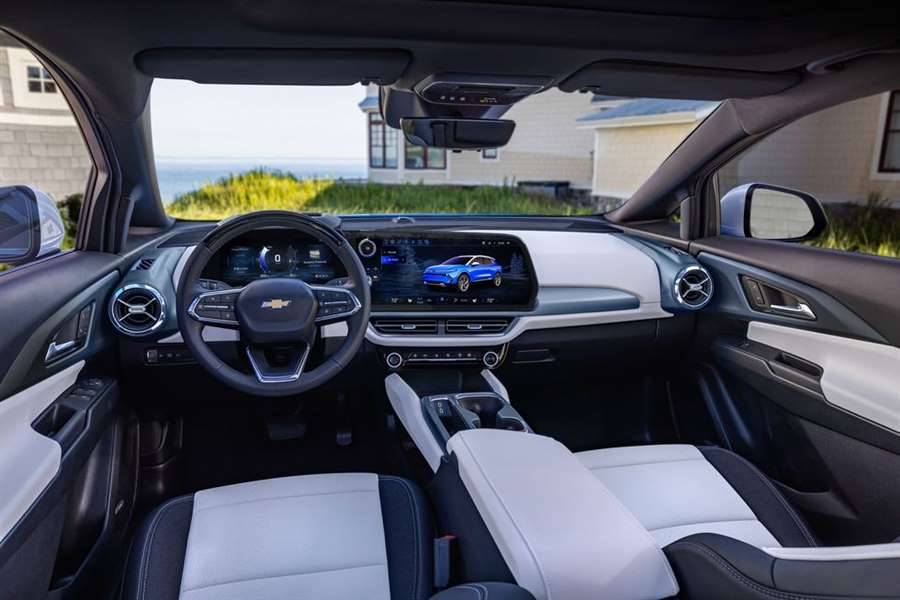
EV Motor, Power, and Performance
Front-wheel-drive Equinox EVs come with a single electric motor that makes 210 horsepower, but opting for the optional all-wheel-drive system ups power to 290 ponies. We haven’t driven the Equinox EV yet, but we’d wager that the front-wheel-drive powertrain will be enough for most drivers, especially given the immediate power delivery that’s typical of electric motors and will likely give the SUV a perky demeanor around town. The smaller Bolt EUV, for instance, makes 10 horsepower less from its single onboard motor but still managed a respectable 6.8-second run to 60 mph at our test track. When we get a chance, we’ll test both front- and all-wheel-drive versions of the Equinox and update this story with the results.
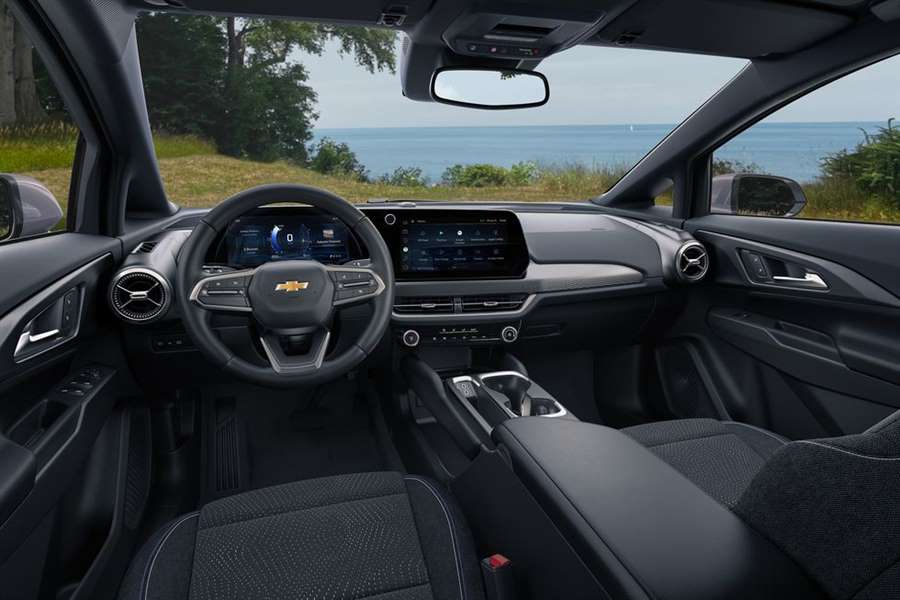
Range, Charging, and Battery Life
Base-level Equinox EV models come with a smaller battery pack than the rest of the lineup and carry a range estimate of 250 miles per charge. All others get a larger battery which can provide up to 300 miles of range, although going with all-wheel drive drops the estimated range down to 280 on those trims. All models come with DC fast-charging capability, and Chevrolet says that can add 70 miles of range to the battery in as little as 10 minutes.
Fuel Economy and Real-World MPGe
The EPA hasn’t released fuel economy ratings for the Equinox EV yet, and we don’t expect to have that information from the government until closer to the SUV’s launch. Once we get a chance, we’ll take the Equinox EV on our 75-mph highway fuel economy route to test its efficiency and range. For more information about the Equinox EV’s fuel economy, visit the EPA's website.
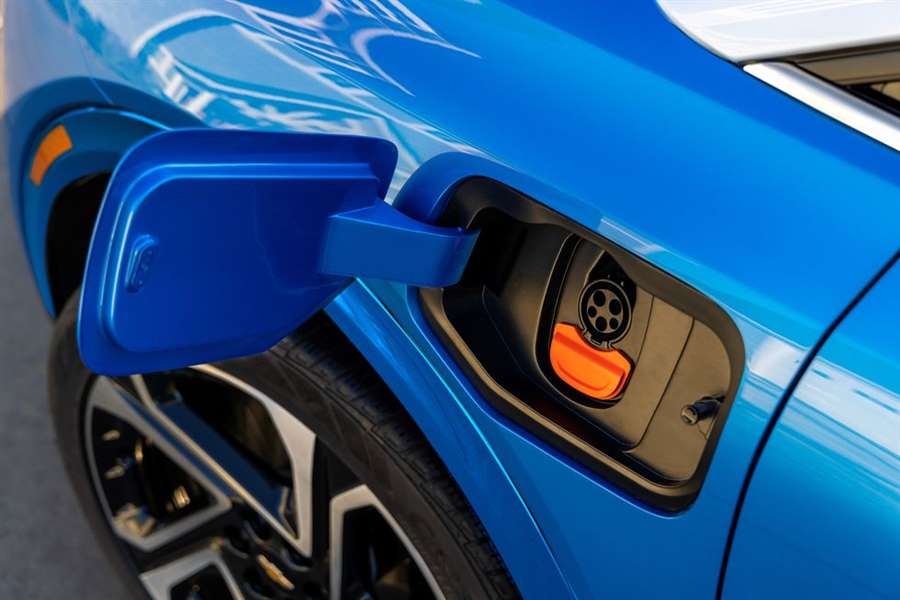
Interior, Comfort, and Cargo
Although the Equinox EV’s cargo capacity isn’t quite as capacious at 57 cubic feet with the rear seat stowed, the rest of the interior feels about as roomy as the gasoline-powered model. Inside, buyers will find a digital dashboard similar to that of the recently revealed Silverado EV and styling themes that mirror the Bolt EV hatchback and Bolt EUV crossover. Base models are fairly basic and lack even power-adjustable front seats, but moving up to the 2LT, 3LT, and RS trims unlocks plenty of features including heated seats, power seats, a sunroof, dual-zone climate control, and more. Opt for the 2RS and 3RS models and you can order the saucy Adrenaline Red interior theme.
Infotainment and Connectivity
Every Equinox EV comes with an 11.0-inch digital gauge display with a secondary touchscreen for infotainment. In the 1LT model, that infotainment display is 11.0 inches but a larger 17.0-inch screen is optional on 2LT and 2RS models and standard on the 3LT and 3RS. Chevrolet hasn’t released a full list of standard and optional features yet, but we expect to see wireless Apple CarPlay and Android Auto as standard across the lineup with uplevel models getting in-dash navigation and an onboard Wi-Fi hotspot.
Safety and Driver-Assistance Features
All models will ship with basic driver-assistance features as standard, including automated emergency braking, automatic high-beam headlamps, and lane-keeping assist. For buyers seeking the most up-to-date tech, the Equinox EV will be offered with GM’s Super Cruise hands-free driving system. For more information about the Equinox EV’s crash-test results, visit the National Highway Traffic Safety Administration (NHTSA) and Insurance Institute for Highway Safety (IIHS) websites. Key safety features include:
Standard automated emergency braking with pedestrian detection
Standard lane-departure warning with lane-keeping assist
Available adaptive cruise control with hands-free driving mode
Warranty and Maintenance Coverage
Chevrolet provides standard coverage limits for the Equinox EV’s electric powertrain components. It also includes the first maintenance visit, but overall coverage doesn't come close to that of the Hyundai Ioniq 5.
Limited warranty covers three years or 36,000 miles
Powertrain warranty covers five years or 60,000 miles
Complimentary maintenance covers one maintenance visit
Electric components are covered for eight years or 100,000 miles
Source: caranddriver.com
The Bugatti Centodieci is one of the most expensive cars in the world
Another Centodieci was produced, which means that the handover is ready.
We have no doubt that the future owner, despite being "shorter" by at least eight million, will sit down in this truly special car with a smile every time. A silver finish was chosen, and before leaving for its new owner, the car was photographed in the company of its ancestor, the legendary EB110 Supersport from 1992.
Only now, side by side, these two cars show aesthetic similarities. Of course, the decades-long time difference has taken its toll, but it would be difficult to single out a more attractive car here.
Let's remind, Supersport in translation means that it is slightly more powerful and lighter than the GT version, and it boasts of appropriate body modifications to achieve better aerodynamics.
It's powered by a 612bhp 3.5 V12 quad-turbo mated to a six-speed manual – impressive even today, let alone in the 1990s. It reached 100 km/h in a then incredible 3.2 seconds and a maximum of 355 km/h.
Centodieci offers a familiar story. 8.0 V16 with 1600 HP and dream performance. It does not stop until 380 km/h, and reaches 100 km/h in 2.4 seconds.
And finally, let's say that the original was produced in 30 copies, and on the used market it is still cheaper than the reincarnated model. Of the ten planned examples of the Centodieci model, only three have so far been seen in public.
The first, white version, was spotted in 2019, and the blue version only recently.
All ten cars will reportedly be completed by the end of the year.
The Brabus beast weighs three tons and reaches 100 km/h in 3.7 seconds
Brabus has a new toy for the rich that can be admired by all those who see sense in such exaggeration.
The Mercedes G-Class is one of the most luxurious SUVs in the world in its own right, which is hard to fault. For many, it is just a dream car, and to a lesser extent, just the basis from which to create a real dream car.
It is "especially difficult" for the latter, so Brabus will help them in their plans. Mercedes' tuning experts are particularly imaginative on the G-Class, so now they present another special version, limited to only ten examples.
The name says it all, so the Brabus P 900 Rocket Edition offers 900 hp, which represents far more dynamic performance than the lifted 800 Adventure XLP. Although it is lowered and adapted to the road, this model is still over two meters tall.
The body is decorated with an abundance of carbon, and the novelty in the offer is a transparent panel on the engine cover and LED lighting for literally everything. It is mounted on huge 24-inch rims.
Inside, the same story, but with an abundance of the finest leather. Rear passengers also get screens, and in addition to the ambient lighting, the Brabus logos are also illuminated. As we said, there are no off-road portal axles here, instead Brabus has opted for adjustable suspension for greater comfort and even better roadholding.
4.5 V8 biturbo The V8 produces the aforementioned 900 hp with an imposed torque limit of 1050 Nm. It reaches 100 km/h in an incredible 3.7 seconds, while the maximum is 280 km/h. We are talking about a 2.7 ton monster! Disc brakes with a diameter of 400 mm ensure a safe stop.
The Brabus P 900 Rocket Edition One of Ten is about 170,000 euros more expensive than the shorter version without the rear bunker, i.e. the starting price is 649,638 euros without tax.
Everyone wants a Ferrari Purosangue
According to reports from Italy, Ferrari has been swamped with orders for its €390,000 Purosangue crossover and could be forced to close its order book.
Unlike competing luxury brands whose SUVs often make up the lion's share of their sales, Ferrari has decided to limit production of its first crossover to no more than 20 percent of annual production in order to maintain exclusivity.
Even assuming that Ferrari's total production of all models rises to 15,000 with the addition of the new model line, that still only amounts to 3,000 cars per year. And that may not be nearly enough to keep up with demand, Jutarnji.hr states.
"We risk not being able to meet demand and may very soon have to close orders," said Ferrari's chief commercial and marketing officer, Enrico Galliera.
The Purosangue uses a naturally aspirated V12 under the hood, a feature that none of its performance-focused competitors offer, which may explain the rush of pre-orders. Galliera claims interest "exploded" when the company announced the Purosangue would use a V12.
Ferrari is likely to add smaller-capacity hybrid models later, borrowing either the hybrid V8 powertrain from the SF90 or the electrified V6 engine from the 296 GTB, whose 3.0-liter capacity would help avoid the heavy taxes imposed on big engines in China where the model is likely to be very popular.
Still, the V12 in the Purosangue is likely to be a big factor in convincing existing die-hard Ferrari owners that the Purosangue is worthy of wearing the Ferrari badge. Ferrari says it will prioritize delivery to current owners over buyers new to the marque.
"Every Ferrari owner wants to own a Purosangua and we have to reward them, because they are the ones who made Ferrari what it is today," Galliera told Automotive News Europe.

















